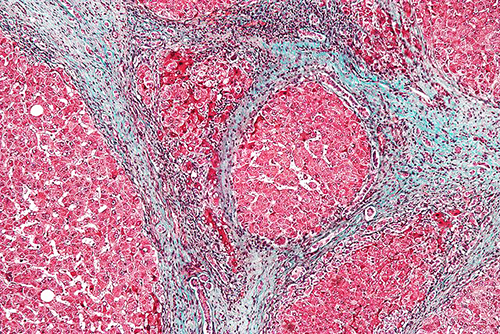By mining results of unrelated blood tests, the CIRRUS algorithm can inform doctors and patients earlier than usual of liver disease
For years Dark Daily and its sister publication The Dark Report have predicted that the same type of analytical software used on Wall Street to analyze bundles of debt, such as car loans, mortgages, and installment loans, would eventually find application in healthcare and clinical laboratory medicine. Now, researchers at the University of Southampton in England have developed just such an analytical tool.
The UK researchers call their algorithm CIRRUS, which stands for CIRRhosis Using Standard tests. It can, they say, accurately predict if a patient has cirrhosis of the liver at a much earlier stage than usual and produce information that is clinically actionable, using results from several common, routinely-ordered medical laboratory tests.
The University of Southampton scientists published their findings in BMJ Open.
Currently, the leading edge for this in clinical laboratory medicine is analysis of digital pathology images using image analysis tools and artificial intelligence (AI). However, CIRRUS is an example that analytical software is advancing in its ability to mine data from a number of clinically-unrelated lab tests on a patient and identify a health condition that might otherwise remain unknown.
The UK researchers designed the CIRRUS algorithm using routine clinical laboratory blood tests often requested in general practice to identify individuals at risk of advanced liver disease. These tests include:
Reversing Liver Disease through Lifestyle Changes
“More than 80% of liver cirrhosis deaths are linked to alcohol or obesity and are potentially preventable,” noted Nick Sheron, MD, FRCP, Head of Population Hepatology at University of Southampton, and lead author of the study, in a press release. “However, the process of developing liver cirrhosis is silent and often completely unsuspected by GPs [general practitioners]. In 90% of these patients, the liver blood test that is performed is normal, and so liver disease is often excluded.
“This new CIRRUS algorithm can find a fingerprint for cirrhosis in the common blood tests done routinely by GPs,” he continued. “In most cases the data needed to find these patients already exists and we could give patients the information they need to change their lifestyle. Even at this late stage, if people address the cause by stopping drinking alcohol or reducing their weight, the liver can still recover.”
Mining Clinical Laboratory Blood Test Results
To perform the study, the research team analyzed data on blood test results for nearly 600,000 patients. Unlike most diagnostic liver algorithms, the CIRRUS model was created using a dataset comprised of patients from both primary and secondary care without the main intent of preselecting for liver disease. This renders it better suited for detecting liver disease outside a secondary care hepatology environment.
“Whilst we are all preoccupied with the coronavirus pandemic we must not lose sight of other potentially preventable causes of death and serious illness,” said Michael Moore, BM, BS, MRCP, FRCGP, Professor of Primary Health Care Research and Head of Academic Unit Primary Care and Population Sciences at University of Southampton, in the press release. Professor Moore co-authored the CIRRUS study.
“This test using routine blood test data available, gives us the opportunity to pick up serious liver disease earlier, which might prevent future emergency admission to hospital and serious ill health,” he said.

According to the National Institute of Diabetes and Digestive and Kidney Diseases (NIDDK), cirrhosis is most common in adults ages 45 to 54 and about 1 in 400 adults in the US live with the disease. However, the actual number may be much higher as many people are not aware they have cirrhosis, because they do not experience symptoms until the liver is badly damaged.
The NIDDK reports complications from cirrhosis include:
- Portal Hypertension, a condition where scar tissue partially blocks the normal flow of blood through the liver,
- Infections,
- Liver Cancer,
- Liver Failure,
- Bone diseases, such as osteoporosis,
- Gallstones,
- Bile duct issues,
- Malabsorption and malnutrition,
- Bruising and bleeding easily,
- Sensitivity to medicines,
- Insulin resistance, and
- Type 2 diabetes.
“Liver cirrhosis is a silent killer. The tests used most by GPs are not picking up the right people and too many people are dying preventable deaths. We looked at half a million anonymous records and the data we needed to run CIRRUS was already there in 96% of the people who went on to have a first liver admission,” stated Sheron in the press release. “With just a small change in the way we handle this data it should be possible to intervene in time to prevent many of these unnecessary deaths.”
“Alcohol-related liver diseases are far and away the most significant cause of alcohol-specific deaths, yet currently the vast majority of people find out that their liver is diseased way too late,” said Richard Piper, PhD, Chief Executive of Alcohol Change UK, a British charity and campaign group dedicated to reducing harm caused by alcohol abuse. “What is needed is a reliable means of alerting doctors and their patients to potential liver disease as early as possible. The CIRRUS process shows real promise, and we want to see it further developed, tested and implemented, to help save hundreds of thousands, if not millions, of lives.”
CIRRUS is a true milestone in the development of computer-assisted healthcare diagnostics. It will need more research, but the University of Southampton study shows that analytical software tools can mine clinical laboratory test results that were ordered for unrelated diagnostics and identify existing health conditions that might otherwise remain hidden to the patient’s physicians.
—JP Schlingman
Related Information:
Routine Blood Tests Could Be Key to Stopping the Silent Killer of Liver Disease
New Algorithm Can Predict Advanced Liver Disease
Routine Blood Tests Contain ‘Hidden Fingerprint’ Indicating Liver Cirrhosis



